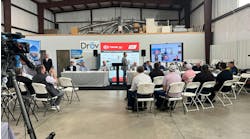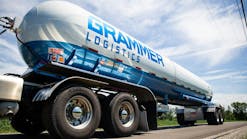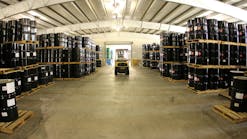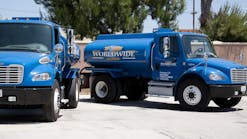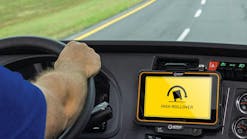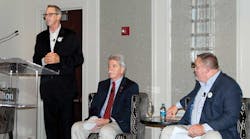USHER Transport’s Dave Edmonson explained the meaning behind the title of the panel he moderated: “Horseshoes and Nuclear War Discussion: How to Handle Near-Miss Accidents.”
“It seems like whenever we make decisions about improving the safety process or anything to do with safety, we do it based on our failures,” he said. “We’ve had an accident, a spill, a contamination. We’ve had somebody get hurt. That’s the nuclear war. Fortunately, the incidents themselves are too few in number to get a good base or set of data. So what do we do? We add in the near miss. Because let’s face it, these are the horseshoes: the leaners, the close ones. Every now and then we have a ringer. The reason to add up near misses is to give us more data, because they’re equal in every way to an accident, with the exception of one thing: We didn’t have a failure, didn’t have a spill, didn’t have a contamination. So it gives us more data points to include in our decision-making process.”
Edmonson moderated the panel during the National Tank Truck Carriers Tank Truck Safety & Security Council annual meeting June 20-22 in Nashville, Tennessee. Panelists included Terry Kolacki of GLS Transport Inc and Ray Riley of Miller Transporters Inc.
To provide an example of how an accident could have been prevented had he known about a previous near miss, Edmonson told “the pig story.”
He said that in January, he was walking to lunch during a convention when his phone rang. It was one of his customers, and she wanted an update on a driver who tripped over a pig and broke his arm. He didn’t know about it, so he tracked down the story about a driver who was offloading at a meat-packing facility in Louisville, Kentucky.
“They were in the middle of a construction project and had things boarded up,” Edmonson said. “Their normal process involves (butchered) pigs that failed to meet USDA inspection. With all their construction, they didn’t have any place to put the pig (carcasses), so they laid them out right where the driver gets out of the truck. They had eight of them stacked like cord wood. So this driver is trying to get into his truck to take off after delivering. He trips over a pig and breaks his elbow.
“The moral of my story: I get back to Louisville. I start talking to dispatch and other drivers. They heard what’s going on. A driver comes up to me and says, ‘Yeah, I won’t deliver to that place.’ This was a 20-year veteran. He said, ‘That place is a mess. It’s been that way for years. The place is a slip hazard.’ I was like, ‘Wow. Why didn’t you bring this to me before?’ He said, ‘Well, I didn’t want to raise a fuss.’
“So that’s my accident that I could have been prevented had I known. Had that 20-year veteran come to me and said, ‘Hey, this place is a mess, and you need to go look at it.’ … So I go to inspect the place. Sure enough, the unloading area is six feet from a live railroad track that they have no control over. There’s grease. The tank we’re pumping into isn’t marked. The automatic tank gauge doesn’t work.”
Q: How do you guys handle a near miss? More importantly, we want to try to figure out, how do we get our drivers, our men and women behind the wheel, to let us know they’ve had a near miss?
Riley: Getting drivers to report near misses is difficult. I think all of us have experienced that. Something happens, and then how many drivers do you have that come up to you and say, “Oh, I knew something was going to happen”? It’s difficult at best. I’ll tell you right up front: We have not conquered that. We continue to encourage our drivers to report near misses.
You asked me what would be a good example of one. We had an accident a few years ago and after it happened, we started to go back and look at the question: What did we miss? And we actually had in our accident records what in some instances you could classify as near misses. The information was there in front of us, but we never added it up until the bad one happened. When we looked back and analyzed that, we said, “Here we had these incidents, and most times were very minor—just a little ding here, a little ding there. The driver was very honest about reporting when things happened.” But then we started looking at it and we said, “Why did we all think that this was such a great driver?” A great person, no doubt about it. But once or twice a year, we had some little something happen, and we didn’t add it up until the worst had happened.
We started looking at: “OK, we’ve got to look at that because in over 10 years we’ve had 10 minor incidents. How many close calls did that gentleman have before he had the bad one happen to him?” It wasn’t bad driving per se, but it was bad decision-making. He got himself in a situation where he missed a turn and instead of going down and getting turned around and headed back the right way, what did he do? He made a U-turn and there was a collision, and a guy on a motorcycle died as a result of it. In the investigation, they found that the motorcycle rider was intoxicated and speeding, but still, this ruined the driver’s career and he now has to live with the knowledge that he made a bad decision that resulted in someone dying. We have constantly gone back and said, “What did we miss? We need to pay more attention. And how can we get drivers to report close calls?”
One of the approaches we’ve taken is trying to get other drivers to look at this not that they’re being a snitch or telling on someone, but they’re helping that other driver to identify a bad habit or something they’ve done that could be done better—even to the point of getting them to maybe write it down or getting their wife to write it down so nobody could recognize the handwriting, and send it to us in a feedback and point us in the right direction. We’re trying to get those guys to understand that we worked hard to get each and every driver here and are going to keep each and every one. So if you see a driver doing something that’s going to lead to an incident or see a bad situation at a plant, come to us and get it to us in some form so that we can go and investigate that or maybe get with that driver and do extra training.
Q: Terry, when you get someone reporting a near miss, how do you usually hear about it? Do you have a written form?
Kolacki: Being in business with bigger companies, as a lot of you guys are, they want near misses from us. We don’t have a form, but what I tell the guys is, “Just call me. Don’t worry about filling out the form. Just call me and I’ll take care of it. I’ll tell you that when you do have a near miss, you’d better make sure you take care of it and some action is taken.” We work for a good parent company and when a couple of near misses were turned in, they sent out $50 gift cards and jackets to these guys. Even after that, it’s still hard to get these guys to put a near miss in. Absolutely it’s the right thing to do, but when you have a near miss reported, you have to take a step and take corrective action.
We had a facility we were going to deliver to. They wanted the delivery at night. They were expecting our driver to deliver at night with no safety shower, no running water available in case something happens. Thank God the driver called us. We called the plant manager and told him what was happening. We couldn’t get anything done from the customer, so we made the decision that we were not going there anymore. We called the shipper and told them it was totally unsafe for us to go there, but at least we backed up our driver, and they know that if they come to us with something, we’re not just going to let it slide. Nine times out of 10 with a customer location, if you tell them about a problem that driver told you about, they’re grateful. They look at it as, “Thanks for letting us know.” It makes your company look a lot better. Unfortunately, there are some customers out there that aren’t going to change for us.
Q: There’s a perception among drivers that if they report something, there will be repercussions on them or they’ll think they’ll be labeled a whiner. How do you get your people to report near misses? Do you reward them for reporting it? Do you do nothing other than say thanks?
Kolacki: We share all the incidents with the drivers. It’s easy to let them know that, “Hey, we’ve made some progress on this. We had a near miss turned in and we made some progress. We saved a potential accident.” We let them know where it was. We reward our drivers in positive points toward a safety incentive bonus. And it’s still not enough. I would love to do more for them to reward them because it is a huge part of our business.
Riley: We have a form that drivers can fill out if they want to. They can also do it electronically from the truck. Our president, Lee Miller, set up a system several years ago in which all of these reports go to our recruiting and retention department, and the manager of that department is responsible for going to whomever it is in charge of that issue. It may be that it had to go to the sales department to work it back through with the shipper. It may go to the VP of operations. It may come to safety or maintenance. They have to answer to that driver. That is a directive from Lee Miller—that if the driver brings something to our attention, he will get an answer. When you get that first email from the recruiting and retention group saying, “We’d like to have an answer within the week,” and then you get another one saying that you didn’t answer in time, you see Lee Miller. Lee has made that commitment to the driver that if you point out something—a customer location, a truck, or a product we’re handling, whatever it is—you will get an answer. It might not be the answer you want, but like he puts it, that driver deserves an answer.
The technology we have today is giving us a lot of those near misses that for years we never had—like hard braking demands, your stability controls. Aren’t all of those also near misses? It’s a challenge to manage it and act on it, but I think with the cameras that are coming, we’re getting more and more tools. We should be able to do better in knowing which drivers need that attention. We can now pinpoint our resources instead of a shotgun blast.
Q: What do you folks do at your places to get drivers to report? Do you have formal or informal system?
Riley: We have a form we use. It’s a near-miss form. We’ve had a program in place since 2005. We’ll get a fresh pot of coffee going and listen to the guys. The average driver today doesn’t see it as near misses. That’s just part of a truck driver’s job. So you have to pick and choose and look for that opportunity. We look for that opportunity to recognize them and then we make a note of it. The safety director comes around and does quarterly safety meetings. One of the things he asks is if anybody has had a near miss. Sometimes we’ll get somebody who will step up. We’ll praise that guy. That goes a long way. Recognize that guy. Thank him for doing what he’s doing. We’ve already taken a near miss form after he’s told us about it and posted it on the wall. We scanned it and sent it to all the terminals that are applicable. And then personally recognize the guy for what he’s done. That goes a long way.
Kolacki: I had a different spin with a new hire I brought in. I asked him, “Did you have a critical event at your last company?” He said, “Yes.” This guy took it personally that nobody checked up on it and nobody was looking at it. They want to see messages. They want to know somebody’s out there watching over them.
Q: What about the anonymity option? It doesn’t allow you to actually address it with the specific driver, but in general OSHA reporting, OSHA does allow anonymous near-miss reports.
Riley: With us, we have a form, and if it gets filled out and the driver doesn’t put his name on it, I’m OK with it. I just want to know. I tell my guys I don’t care how I find out—I just want to find out. At the end of the day, I want to make sure all of my guys and everybody around them go home. I’m sure it’s probably the same for the rest of us here. ♦

